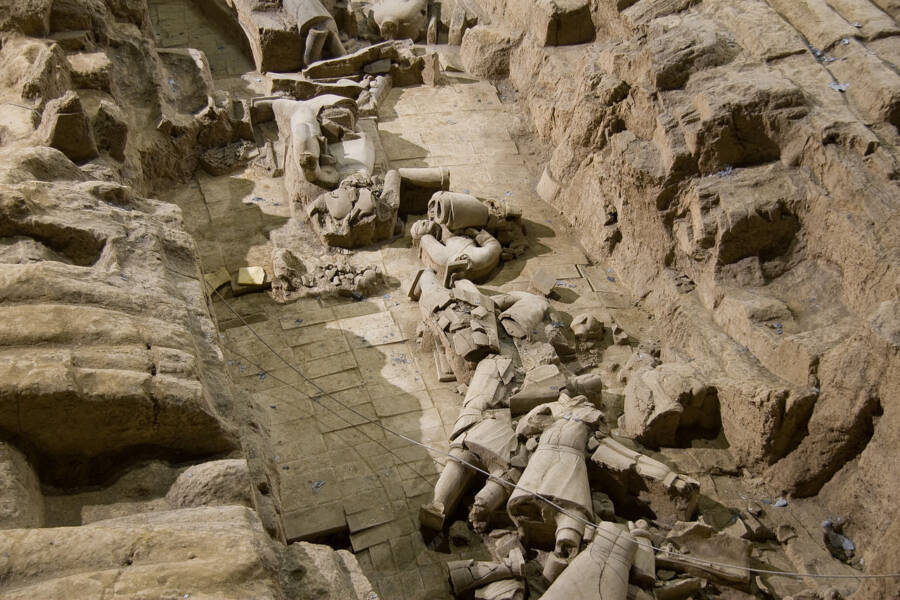The Chinese tourist jumped into a pit and "pushed and pulled" at the terracotta warriors, visibly damaging two of them.

Kevin Poh/FlickrA group of the terracotta warriors of Emperor Qin Shi Huang.
China’s Terracotta Army, a remarkable collection of 8,000 clay sculptures of life-sized warriors, was constructed more than 2,000 years ago on the order of Emperor Qin Shi Huang. But it took a tourist just a few minutes to damage two of the warriors at the museum complex in Xi’an, China, where the army is on display.
After jumping over a guardrail, the tourist — who was seemingly struggling with a mental health problem — attacked the warriors as horrified witnesses yelled at him to stop. He ultimately damaged two “to varying degrees.”
The Tourist Who Damaged The Terracotta Army
According to a statement provided to the Agence France-Presse, the incident occurred on May 30, 2025. The man — a “domestic tourist” identified only by his surname, Sun — was visiting the Museum of the Terracotta Army of Emperor Qin Shi Huang in Xi’an, China, when he suddenly lunged for the warriors.
Sun hopped over a guardrail and a protective net and down into an 18-foot-deep excavation pit that houses several of the warriors. All the while, his fellow tourists cried out, “What are you doing?”
Ignoring them, the 30-year-old man “pushed and pulled” at the clay warriors, damaging two “to varying degrees.” Videos that circulated online showed Sun then lying on the ground and holding his head before he was “controlled” by security.

Weibo via XThe tourist as seen on videos circulated on social media.
The tourist was found to “suffer from mental illness,” according to Chinese officials, but the case is still under investigation. It’s a shocking and upsetting chapter in the long history of the Terracotta Army, which was first constructed beginning in 248 B.C.E.
The Incredible History Of The Terracotta Army

Bernd Thaller/FlickrSome 8,000 terracotta soldiers have been discovered, but it’s possible that there are more.
Some 2,000 years ago, the Terracotta Army was built on the orders of Emperor Qin Shi Huang, the founder of the Qin Dynasty. Huang unified ancient China and is regarded as the country’s first emperor.
Built to guard the emperor in the afterlife — and as a display of power — the thousands of “soldiers” in the Terracotta Army were mass produced but adorned with specific details. Artisans gave them different eyes, hair, and even facial hair, likely in an effort to represent the different regions of China.
But soon after Huang’s death in 210 B.C.E, the Qin dynasty quickly and violently collapsed. Marauders descended upon the Terracotta Army and stole their real weapons. Amid the violence, a fire broke out and caused the building to collapse upon the warriors, smashing many of them.
And then, for centuries, the Terracotta Army was forgotten.

Public DomainMany terracotta soldiers were found broken and subsequently reassembled.
It wasn’t until 1974 that the Terracotta Army was rediscovered by total accident. That March, a group of peasants were digging a well when they came upon a fragment of a clay figure. This one shard led to more pieces, which led to even more, until thousands of terracotta warriors were unearthed.
Archaeologists estimate that there are some 8,000 figures in all, though there could be more. Many have been reassembled and put on display alongside terracotta horses and ancient bronze weapons like swords, spear tips, and arrowheads that the original looters missed.
It’s a fascinating ancient site and a symbol of one man’s immense power. Forgotten and then rediscovered, the Terracotta Army is one of the most incredible archaeological finds in recent memory. It’s lucky that the tourist who leaped into a pit at the museum in Xi’an didn’t do more damage.
After reading about the tourist who damaged two warriors of China’s Terracotta Army, look through these stunning photos of China’s uninhabited “Ghost Cities.” Or, discover the sad story of Empress Wanrong, the wife of the last emperor of China.





